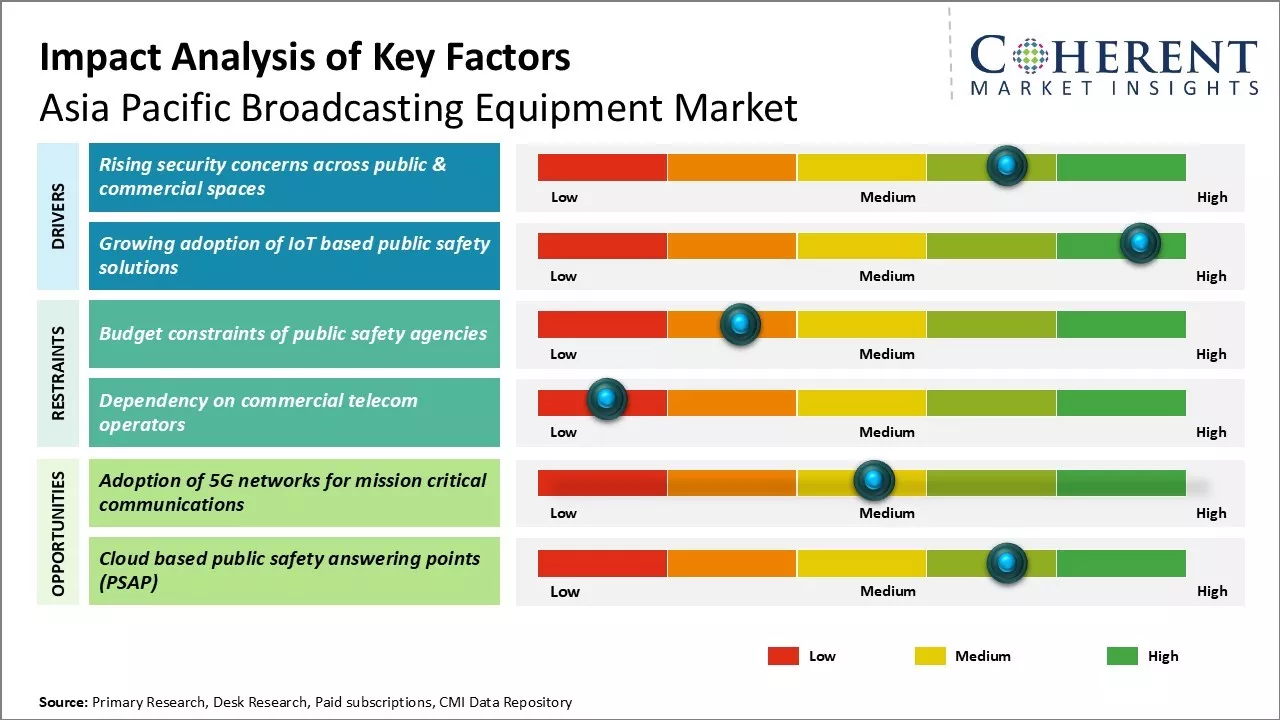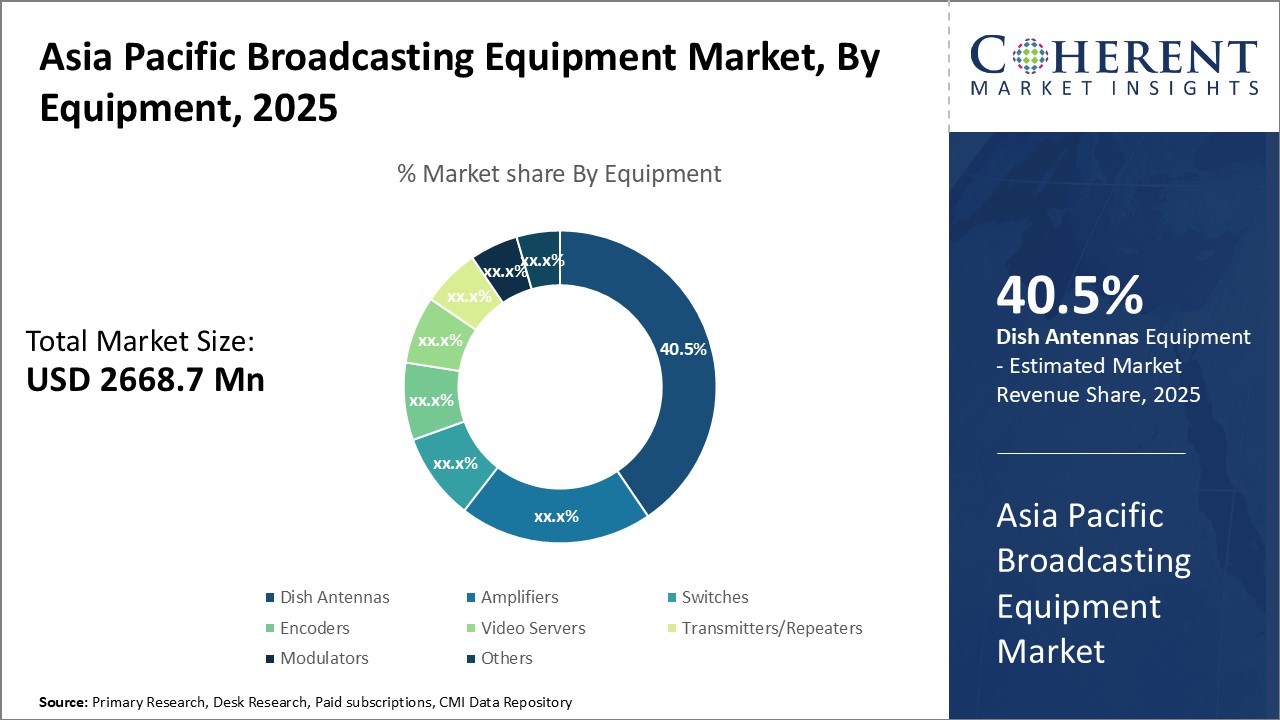Asia Pacific broadcasting equipment market is estimated to be valued at US$ 2,668.7 Million in 2025 and is expected to reach US$ 4,788.4 Million by 2032, exhibiting a compound annual growth rate (CAGR) of 8.7% from 2025 to 2032. Rapid adoption of new technologies across industries has fueled growth in broadcasting. Increased demand for high quality video delivery and improved user experience have propelled investments in broadcasting infrastructure and equipment in recent years.

Discover market dynamics shaping the industry: Download Free Sample
The broadcasting equipment market is witnessing significant growth driven by the rising penetration of smartphones and internet connectivity. Growing popularity of OTT (over-the-top platforms) and live-streaming of sporting events is spurring investments in network infrastructure upgrades. In addition, large-scale government initiatives to digitize content delivery are creating opportunities for broadcasting solution providers. Investments in 5G networks roll-out will further aid market expansion over the coming years.

Discover high revenue pocket segments and roadmap to it: Download Free Sample
Insights By Equipment: Benefiting from Infrastructure Investments, Dish Antennas Dominate the Equipment Landscape
In terms of equipment, dish antennas segment is estimated to hold the highest share of the market of 40.5% in 2025, due to ongoing infrastructure investments across the region. As television remains one of the primary sources of entertainment and information for consumers, countries are pouring resources into upgrading their transmission networks. Satellite broadcast technology allows widespread coverage of remote areas at a relatively lower cost compared to terrestrial systems. This makes dish antennas an appealing solution for broadcasters looking to expand into underserved communities.
Insights By Technology: Analog Broadcasting Maintains Dominance amid Digitization Transition
In terms of technology, analog segment is estimated to hold the highest share of the market of 64% in 2025, due to the massive scale of legacy infrastructure and gradual nature of regional digitization initiatives. Although digital broadcasting provides significant quality and efficiency advantages, transitioning entire networks presents formidable technical and financial challenges. This allows analog signals to maintain widespread reach, particularly in less developed markets.
Insights By Application: Radio Broadcasts Lead Application Segments
in terms of application, radio broadcasts segment is estimated to hold the highest share of the market of 35.1% in 2025, due to its pervasive reach and affordability and infrastructure requirements. Radio remains a widely used and accessible mass medium across the region, enabling it to occupy the highest share. Particularly in developing Asian Pacific nations, radio serves as a critical source of information for large segments of the population and is less dependent on television set ownership and video capable devices.

Get actionable strategies to beat competition: Download Free Sample
Top Strategies Followed by Asia Pacific Broadcasting Equipment Market Players
Established Players:
R&D Investment: Leading companies in the Asia Pacific broadcasting equipment market heavily invest in research and development to deliver cutting-edge, innovative products. For example, Sony spends over 5% of its annual revenue on R&D. This helps the company sustain its position with high-performance cameras, switchers, and audio equipment. Panasonic similarly focuses on R&D, recently unveiling new AI-powered cameras with advanced tracking capabilities.
Mid-Level Players:
Cost-Effective Solutions: Mid-tier players differentiate by offering affordable, quality solutions. For example, JVC (Japan Victor Company), a Japan-based electronics brand known for its high-quality audio-visual equipment, including cameras, projectors, and headphones, focuses on delivering budget-friendly professional video cameras and production switches. This targets cost-conscious broadcasters and production houses. Blackmagic Design partners with manufacturers in India and China to keep costs low for its recorders, converters, and video assistants. This enhances accessibility for budding producers.
Small-Scale Players:
Niche Specialization: Small players survive by targeting specialized market niches. For example, Open Broadcast Systems provides software-defined video routing solutions geared toward IP-based workflows. Atomos specializes in premium on-camera recorders for DSLR (Digital Single-Lens Reflex) and mirrorless cameras. This fulfills needs of documentary filmmakers and independent creators.
Emerging Startups in the Asia Pacific Broadcasting Equipment Market
Innovative Technologies:
Examples: Startups like Anthropic (AI safety), Vantage Robotics (robotics), and Kinema Systems (machine vision) are developing advanced technologies. Kinema Systems creates visual tracking software for broadcast studios using computer vision. This could transform how virtual sets are produced.
Market Contribution:
Niche Markets: Startups often target unique or underserved market niches. For example, companies like 360rr and LiveStitch focus on 360-degree and VR video production. This taps the growing market for immersive video formats.
Key Takeaways from Analyst
Asia Pacific Broadcasting Equipment Market Report Coverage
| Report Coverage | Details | ||
|---|---|---|---|
| Base Year: | 2024 | Market Size in 2025: | USD 2,668.7 Mn |
| Historical Data for: | 2020 To 2024 | Forecast Period: | 2025 To 2032 |
| Forecast Period 2025 to 2032 CAGR: | 8.7% | 2032 Value Projection: | USD 4,788.4 Mn |
| Segments covered: |
|
||
| Companies covered: |
Cisco Systems, Inc., Global Invacom., Wellav Technologies Ltd, Hangzhou DIBSYS Technologies Co., Ltd, Media Excel Inc., Rohde & Schwarz, ChyronHego Corporation, Oracle Corporation, Tedial S.L., Enesys Technologies, and Bridge Technologies Co AS |
||
| Growth Drivers: |
|
||
| Restraints & Challenges: |
|
||
Uncover macros and micros vetted on 75+ parameters: Get instant access to report
Market Driver - Rising security concerns across public & commercial spaces
With the growing threat of terrorism as well as regular crimes across cities, both public as well as private establishments are focusing heavily on beefing up their security infrastructure. Citizens want to feel safe when they are out in public places like malls, metro stations, bus stands etc. A
For example, according to a report by the UN Office on Drugs and Crime, incidents of theft increased by over 15% in major cities across Asia from 2019 to 2021. In response, governments have accelerated their efforts to modernize surveillance networks using IP based CCTV cameras, video management software and analytical tools.
Market Challenge - Budget constraints of public safety agencies
One of the key challenges faced by the Asia Pacific broadcasting equipment market is the budget constraints of public safety agencies. Public safety is considered a top priority for governments across the region. However, modernizing communication infrastructure for police, fire and emergency services requires huge capital investments. Due to financial restrictions, it is challenging for public bodies to frequently upgrade their broadcasting equipment to the latest technologies. This can compromise the effectiveness of their operations. For instance, adopting an LTE (Long Term Evolution) or 5G network for enabling capabilities like real-time video streaming and location tracking would require replacing the entire legacy communication infrastructure. Given their limited budgets, public agencies find it difficult to justify such large expenditure. Unless governments increase their modernization allocations for communication networks, this issue of budget shortfalls will continue restricting the spending ability of important clients in this market.
Market Opportunity - Adoption of 5G Networks for Mission Critical Communications
The rollout of 5G networks across Asia Pacific presents a major opportunity for the broadcasting equipment market. 5G is being viewed as a game-changer for mission critical communications used by public safety organizations. It’s extremely low latency, high bandwidth and support for cutting-edge applications open up possibilities for transforming how emergency responders communicate and coordinate. For example, 5G can enable real-time streaming of high-quality videos from body-worn cameras. It allows critical data like building schematics and location details of nearby hospitals to be accessed in seconds on the move. As governments facilitate the adoption of 5G-powered solutions tailored for police, fire and medical services, it will generate substantial demand for 5G-ready broadcasting equipment among these clients. Leading equipment vendors who develop innovative mission critical communication products leveraging 5G capabilities will be well-positioned to tap into this fast-growing segment of the market.
Share
Share
About Author
Suraj Bhanudas Jagtap is a seasoned Senior Management Consultant with over 7 years of experience. He has served Fortune 500 companies and startups, helping clients with cross broader expansion and market entry access strategies. He has played significant role in offering strategic viewpoints and actionable insights for various client’s projects including demand analysis, and competitive analysis, identifying right channel partner among others.
Missing comfort of reading report in your local language? Find your preferred language :
Transform your Strategy with Exclusive Trending Reports :
Frequently Asked Questions
Joining thousands of companies around the world committed to making the Excellent Business Solutions.
View All Our Clients